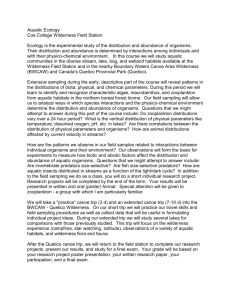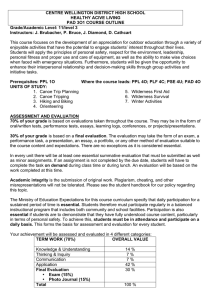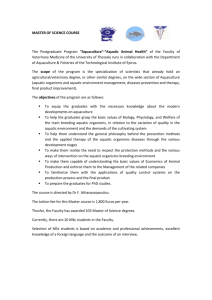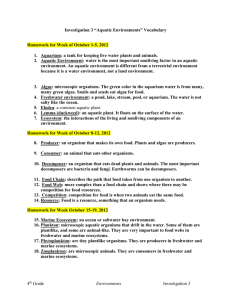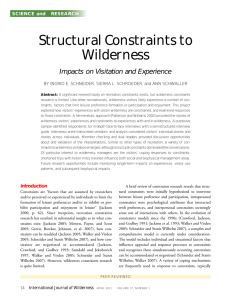Comparative Ecology of Lakes and Streams
advertisement
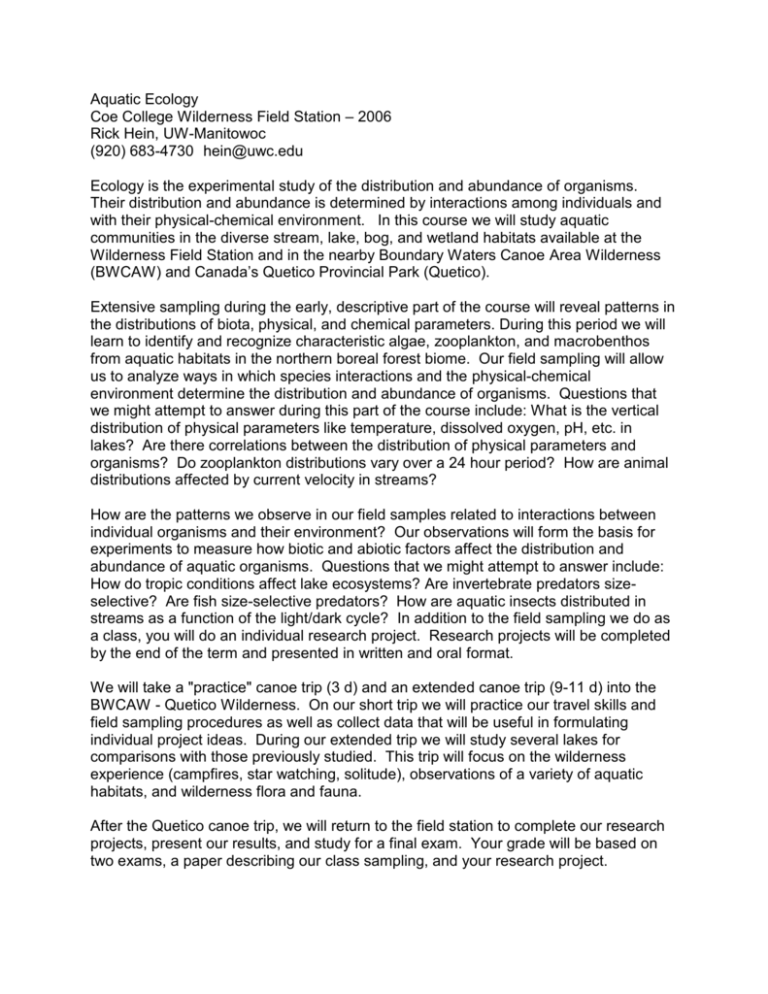
Aquatic Ecology Coe College Wilderness Field Station – 2006 Rick Hein, UW-Manitowoc (920) 683-4730 hein@uwc.edu Ecology is the experimental study of the distribution and abundance of organisms. Their distribution and abundance is determined by interactions among individuals and with their physical-chemical environment. In this course we will study aquatic communities in the diverse stream, lake, bog, and wetland habitats available at the Wilderness Field Station and in the nearby Boundary Waters Canoe Area Wilderness (BWCAW) and Canada’s Quetico Provincial Park (Quetico). Extensive sampling during the early, descriptive part of the course will reveal patterns in the distributions of biota, physical, and chemical parameters. During this period we will learn to identify and recognize characteristic algae, zooplankton, and macrobenthos from aquatic habitats in the northern boreal forest biome. Our field sampling will allow us to analyze ways in which species interactions and the physical-chemical environment determine the distribution and abundance of organisms. Questions that we might attempt to answer during this part of the course include: What is the vertical distribution of physical parameters like temperature, dissolved oxygen, pH, etc. in lakes? Are there correlations between the distribution of physical parameters and organisms? Do zooplankton distributions vary over a 24 hour period? How are animal distributions affected by current velocity in streams? How are the patterns we observe in our field samples related to interactions between individual organisms and their environment? Our observations will form the basis for experiments to measure how biotic and abiotic factors affect the distribution and abundance of aquatic organisms. Questions that we might attempt to answer include: How do tropic conditions affect lake ecosystems? Are invertebrate predators sizeselective? Are fish size-selective predators? How are aquatic insects distributed in streams as a function of the light/dark cycle? In addition to the field sampling we do as a class, you will do an individual research project. Research projects will be completed by the end of the term and presented in written and oral format. We will take a "practice" canoe trip (3 d) and an extended canoe trip (9-11 d) into the BWCAW - Quetico Wilderness. On our short trip we will practice our travel skills and field sampling procedures as well as collect data that will be useful in formulating individual project ideas. During our extended trip we will study several lakes for comparisons with those previously studied. This trip will focus on the wilderness experience (campfires, star watching, solitude), observations of a variety of aquatic habitats, and wilderness flora and fauna. After the Quetico canoe trip, we will return to the field station to complete our research projects, present our results, and study for a final exam. Your grade will be based on two exams, a paper describing our class sampling, and your research project. Books required: Horne, A.J., and C.R. Goldman. 1994. Limnology, Second Edition. McGraw-Hill, Inc., New York, NY (buy used if possible). Needham, J.G. 1988. A Guide to the Study of Fresh-Water Biology, Fifth Edition. McGraw-Hill, Inc., New York, NY. I will provide a set of supplementary readings. Required Equipment: 1. Notebooks: One notebook suitable for class notes for a 4 week class, 20-30 sheets of plain white paper for drawings, and some mm ruled graph paper. One pocketsized, hardback, field notebook -- these should have waterproof pages and be spiral bound or sewn. They are available with sewn or spiral bindings from Carolina at 1800-334-5551 (e. g., #ER-GE09183 @$5.00), from many engineering/surveying supply stores, or from Forestry Suppliers at 1-800-647-5368 (several types @ ~$6.00-$15.00). The biology department stockroom at most colleges has copies of both these catalogs if you want to comparison shop. 2. Ball point pens and pencils (#2 or 2.5 lead will write in the rain and not smear). Carolina (ER-GE09191 @$7.15) and Forestry Suppliers (#49237 @$8.70) sell a ball point pen that they claim will write in the rain. 3. Calculator. 4. Day pack to hold notebooks, pencils, lunch, etc. when in the field. Heavy zip lock or other closeable plastic bags will help keep things dry in the field. A hip pack is also very useful. Bring it if you have one. 5. Hat, rain gear, and something for bugs (repellent and head net). 6. Pocket knife. 7. Water bottle. 8. Lightweight hiking boots and an old pair of shoes for wading in shallow water, wetlands, bogs, etc. Both will get wet! Suggested Equipment: Fishing equipment, binoculars, camera, polarized or regular sunglasses, field guides (plants, insects, rocks, birds, etc.), a face mask that fits and a snorkel.
